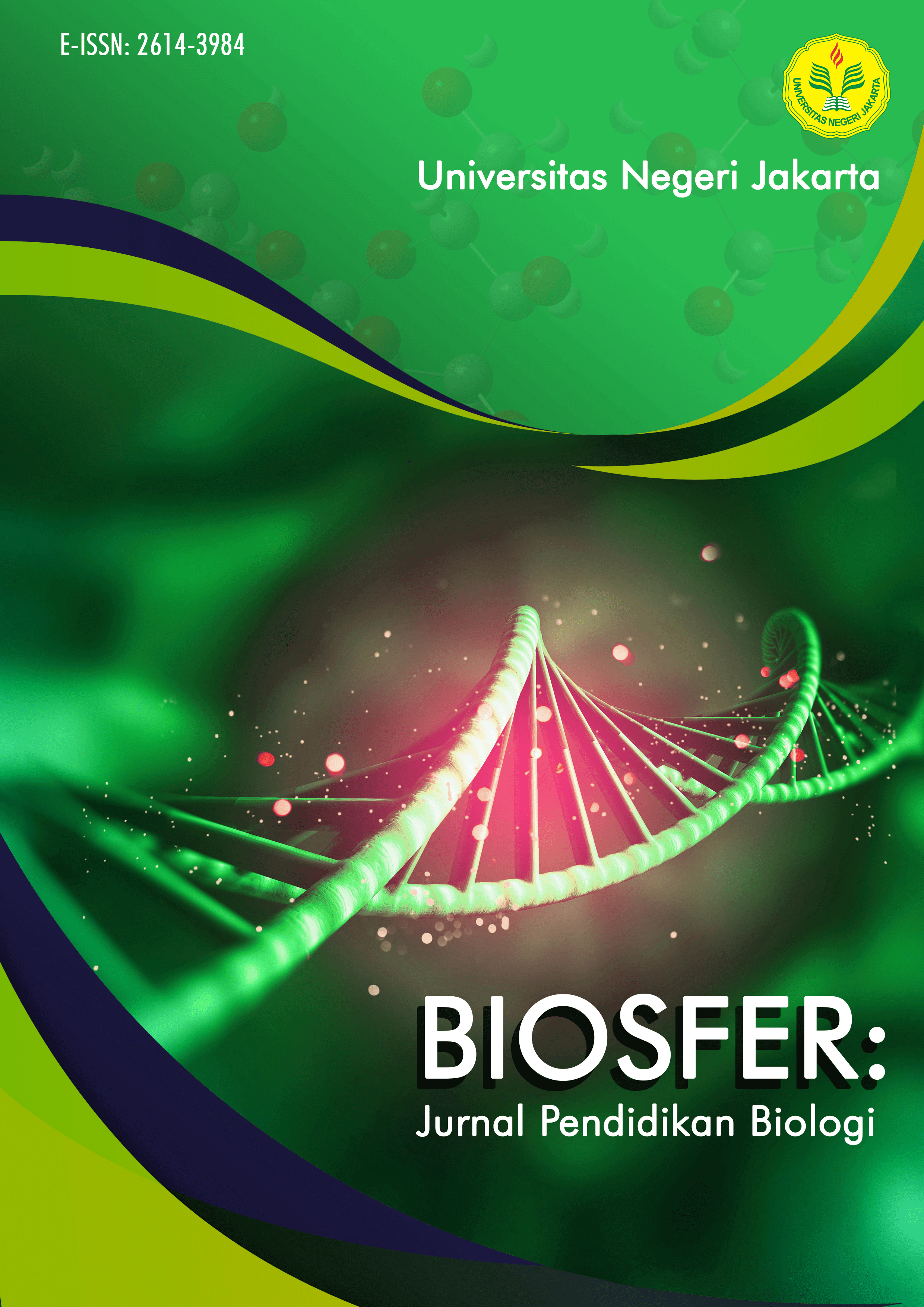Creativity profile of biology teacher candidates: An exploratory study
DOI:
https://doi.org/10.21009/biosferjpb.38636Keywords:
Creativity, Learning activities, Prospective biology teachersAbstract
Abstract: Creativity is one of the important skills that teachers must have today. Creativity can be defined as the human ability to generate new and valuable ideas. In addition, creativity is considered as a basic competency that needs to be possessed by students in higher education. The purpose of this study was to determine the creativity of prospective biology teachers and its relationship with students' knowledge mastery. For this purpose, a descriptive and correlational study was conducted on 13 biology pre-service students. The instrument used in this study was the Torrance creativity test based on 4 creativity indicators: fluency, flexibility, originality and elaboration. Descriptive and correlational analyses were conducted to identify students' creativity profiles and the relationship between students' creativity and their knowledge mastery. The results showed that there were three types of creativity owned by prospective biology teacher students, namely students with low (38.46%), medium (38.46%) and high (23, 07%) levels of creativity. The correlation test results show that concept mastery correlates with student creativity (r=0.3). The conclusion of this study is that prospective biology teacher students have different creativity, and there is a correlation between students' concept mastery and their creativity level so that there needs to be an effort from lecturers by designing learning strategies that can increase student creativity and concept mastery.
References
Biazus, M. de O., & Mahtari, S. (2022). The Impact of Project-Based Learning (PjBL) Model on Secondary Students’ Creative Thinking Skills. International Journal of Essential Competencies in Education, 1(1), 38–48. https://doi.org/10.36312/ijece.v1i1.752
Borodina, T., Sibgatullina, A., & Gizatullina, A. (2019). Developing creative thinking in future teachers as a topical issue of higher education. Journal of Social Studies Education Research, 10(4), 226–245. https://www.learntechlib.org/p/216563/
Cipta, M., St, U., Lapang, K., & District, M. (n.d.). Thinking-Torrance Tes ( BTCT-TT ) Assessment To Improve Student ’ Creative Thinking. 73–83.
Education, D. of. (2004). TITLE : Competency Framework for Teachers (D. of E. and Training (ed.)). Department of Education and Training.
Gieras, J. F. (2019). Creativity and innovations in the 21st century. Przeglad Elektrotechniczny, 95(2), 1–6. https://doi.org/10.15199/48.2019.02.01
Jaenudin, A. (2023). Factors Influencing Creative Thinking in Problem-Solving. Asian Jounal of Engineering, Social and Health, 2(3), 161–170. https://doi.org/10.46799/ajesh.v2i3.47
Jang, S. J., Yang, Y. J., Tong, J., Wei, X., & Dong, E. (2021). Identification of creative imaginations of biology education students based on the wartegg test. In Journal of Physics: Conference Series (Vol. 1806, No. 1, p. 012168). IOP Publishing. https://doi.org/10.1088/1742-6596/1806/1/012168
Kaplan, D. E. (2019). Creativity in Education: Teaching for Creativity Development. Psychology, 10(02), 140–147. https://doi.org/10.4236/psych.2019.102012
Kaufman, J. C., & Sternberg, R. J. (2010). The Cambridge Handbook of Creativity Edited by. Cambridge University Press.
Khotimah, N., & Lestari, P. I. (2023). Pengukuran Kreatifitas Anak Usia Dini Menurut EP Torrance. Alzam: Journal of Islamic Early Childhood Education, 3(1), 40-55. https://doi.org/10.51675/alzam.v3i1.526
Madyani, I., Yamtinah, S., Utomo, S. B., & Saputro, S. (2020). Profile of Students’ Creative Thinking Skills in Science Learning. 397 (Icliqe 2019), 957–964. https://doi.org/10.2991/assehr.k.200129.119
Mazeh, Y. (2020). What Is Creativity and Why It Is So Important?. Open Access Library Journal, 7(3), 1-11. https://doi.org/10.4236/oalib.1105562
Munawaroh, R., Rusilowati, A., & Fianti. (2018). Improving Scientific Literacy and Creativity through Project Based Learning. Physics Communication, 2(2), 85–93. https://doi.org/10.15294/physcomm.v2i2.13401
Nasution, N. E. A., Al Muhdhar, M. H. I., Sari, M. S., & Balqis. (2023). Relationship between Critical and Creative Thinking Skills and Learning Achievement in Biology with Reference to Educational Level and Gender. Journal of Turkish Science Education, 20(1), 66–83. https://doi.org/10.36681/tused.2023.005
Othman, S. N., & Jabari, M. A. A.-. (2012). 2 nd International Conference on Management 2 nd International Converence on Management. June, 221–235.
Pramashela, A. D., Suwono, H., & Wulanningsih, U. A. (2023). The Influence of Project-based Learning Integrated STEAM on the Creative Thinking Skills. 21(2), 138–143. https://doi.org/10.19184/bioedu.v21i2.39737
Pratiwi, R. D., Ashadi, & Sukarmin. (2019). Profile of Students’ Creative Thinking Skills using Open-ended Multiple Choice Test in Science Learning. Journal of Physics: Conference Series, 1397(1). https://doi.org/10.1088/1742-6596/1397/1/012020
Purwati, S., & Alberida, H. (2022). Profil Keterampilan Berpikir Kreatif Siswa di Sekolah. 5.
Redhana, I. W. (2019). Mengembangkan Keterampilan Abad Ke-21 Dalam Pembelajaran Kimia. Jurnal Inovasi Pendidikan Kimia, 13(1). https://doi.org/10.15294/jipk.v13i1.17824
Ridwan, A., Fatimah, C., Hadinugrahaningsih, T., Rahmawati, Y., & Mardiah, A. (2022). Development of 21 st Century Skills in Acid-Base Learning Through STEAM Projects. JTK: Jurnal Tadris Kimiya, 7(1), 121–134. https://pdfs.semanticscholar.org/19be/0aef357e6ea74517df15a5a8fa144203b274.pdf
Setiono, S. (2021). Analisis Respon Mahasiswa dalam Pembelajaran Online Berbasis Aktifitas di Perguruan Tinggi. Jurnal Pendidikan, 9(2), 15–23. https://doi.org/10.36232/pendidikan.v9i2.1095
Sutaphan, S., & Yuenyong, C. (2023). Enhancing grade eight students’ creative thinking in the water STEM education learning unit. Cakrawala Pendidikan, 42(1), 120–135. https://doi.org/10.21831/cp.v42i1.36621
Usmeldi, U., & Amini, R. (2022). Creative project-based learning model to increase creativity of vocational high school students. International Journal of Evaluation and Research in Education, 11(4), 2155–2164. https://doi.org/10.11591/ijere.v11i4.21214
Downloads
Published
How to Cite
Issue
Section
License
The Authors submitting a manuscript do so on the understanding that if accepted for publication, copyright of the article shall be assigned to Biosfer: Jurnal Pendidikan Biologi (Biosferjpb) and Departement of Biology Education, Universitas Negeri Jakarta as publisher of the journal.



